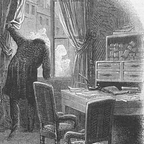The Original Nosferatu Fed on Much More Than Bram Stoker’s Novel
It doesn’t live by much of vampire lore, but Nosferatu feeds like any other
In his commentary, film historian David Kalat called it “an ancient thing” that has “improbably survived.” He was referring to the fact only half of films made before 1950 still exist today. When I write that Nosferatu feeds, I also mean the film.
But first, let’s talk about Dracula.
It’s no secret that Nosferatu is based on Bram Stoker’s novel. It has been misreported that all names were changed to avoid infringing on his copyright. (The film admits being “freely adapted” from Stoker’s work, which is exactly what won Florence Stoker’s 1925 case against the filmmakers.)
But just as the vampire must feed night after night, no single influence was enough to sate Nosferatu.
Director F. W. Murnau drew power from his education. A student of art history, Murnau borrowed from the paintings of the German romantics to set his scene. The works of Caspar David Friedrich, Henry Fuseli and others were turned to the purpose, inspiring, among others, the beachside graveyard where Ellen awaits her husband’s return.
“Mysticism and magic,” writes Lotte H. Eisner in The Haunted Screen, are “the dark forces to which Germans have always been more than willing to commit themselves.” But the art student in Murnau recognised a new influence in German expressionism — insane characters in insane landscapes, as imagined by The Cabinet of Dr Caligari producer Erich Pommer. The expressionist photography of F. A. Wagner, who was widely considered the greatest cinematographer of Weimar cinema, slowly drains the film of the romantic. To Kalat, all that remains are “harsh, angular shadows cutting like teeth into a twisted path that wends into infinity.”
And overseeing this nest of vampires was producer Albin Grau. He designed the sets and iconic makeup. He co-owned Prana Film, the company that Florence Stoker’s legal crusade would help bankrupt. And he was a member of secret societies, the number of which I’m sure you’ll understand I don’t know. Grau’s occultism influenced the cryptic contract between the vampire and his property agent — and even the creature’s name, which he reported to have heard from a Serbian farmer whose father had been turned.
The blood of Nosferatu is not its own. But as the vampire might turn others by offering its wrist, the work of Stoker, Murnau, Wagner and Grau continues to pump through the veins of gothic cinema. If you find yourself craving more, stick around — there’s plenty to sink your teeth into.
